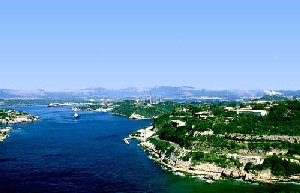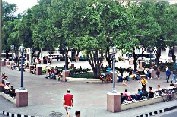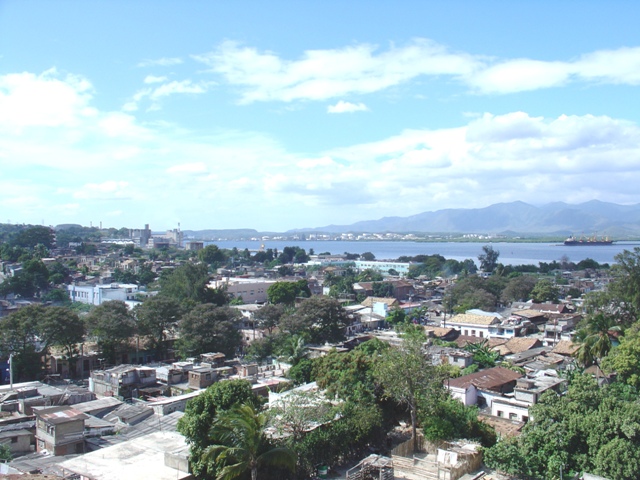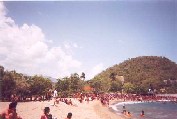(IN SANTIAGO DE CUBA PROVINCE) | Private Houses | Hotel | Places | Maps |
SANTIAGO DE CUBA PROVINCE. INFORMATION
This province is located in the
oriental region of Cuba. It possesses a very mountainous terrain, predominantly
consisting of a range of mountains, ascending from the south from abismal
maine depths which serve as its seat in the Caribbean.
It possesses two important geographical
features: The Sierra Maestra and the Central Valley. In the Sierra Maestra
the highest mountain on the island is found - el Pico Real del Turquino(1 974 m). At Baire the orography forms one the richest mining zones of the archipelago.
The principal economic base of the province is sugar production, for
which eight huge sugar factories are set to work during the harvest.
Of significance are also the citrus, tobacco, copper mining, iron and
manganese industries.
In recent years these zones have benefitted
from increasing industrial development. Santiago de Cuba is also one
of the most relevant turistic poles in the country. It possesses a magnificent
hotel infrastructure with a five-star hotel in the city, and a network
of beach and mountain installations. Its airport is capable of servicing
direct international flights.
Santiago de Cuba Province has the following Municipalities :
Santiago de Cuba, Songo la Maya, San Luis, II Frente, III Frente, Julio A. Mella, Guamá, Contramaeste and Palma Soriano.
 The
provincial capital is Santiago City of Cuba founded by Diego Velazquez
in 1515 by the mouth of the Paradas River; afterwards it was tranferred
to the pace it occupies today. In 1520 its cathedral was constructed,
which was destroyed by fire at the end of six years. During the first
half of the XVI th century Santiago de Cuba was the capital of the country
and the official residence of the Spanish governers, until 1553 when
La Habana assumed that responsibility. Santiago
de Cuba is one of the most protected bays in the island. Santiago, is
the second most populated city in the country. Its port was one of the
most important points of arrival for migrants from the old continent.
In its bay the Spanish fleet surrendered to the Northamerican fleet,
and this fact marked the exit of Spain from the island, which began
a United States domination.
The
provincial capital is Santiago City of Cuba founded by Diego Velazquez
in 1515 by the mouth of the Paradas River; afterwards it was tranferred
to the pace it occupies today. In 1520 its cathedral was constructed,
which was destroyed by fire at the end of six years. During the first
half of the XVI th century Santiago de Cuba was the capital of the country
and the official residence of the Spanish governers, until 1553 when
La Habana assumed that responsibility. Santiago
de Cuba is one of the most protected bays in the island. Santiago, is
the second most populated city in the country. Its port was one of the
most important points of arrival for migrants from the old continent.
In its bay the Spanish fleet surrendered to the Northamerican fleet,
and this fact marked the exit of Spain from the island, which began
a United States domination.
Velazquez´s primary economic
activity was looking for gold, which shortly ran out. The discovery
of copper deposits made the exploitation of the the first mine of this
mineral in Cuba possible, in the zone of El Cobre, near to the city,
where the Church of Cobre is found, in which la Caridad de Cobre, the
patron saint of Cuba is found. The
sanctuary of the virgin Caridad del Cobre is one of the most popular
centers of adoration in Cuba.
 Santiago de Cuba was the object
of lust of many pirates and corsairs who would assalt it quite frequently.
The most famous of its attackers was Francis Drake of Sores. To protect
it from such pillage, in 1633 the authorities initiated the costruction
of a defense system round about the city. El Castillo del Morro (a naval
fortress), and Las Baterias de la Socapa were objects of lust of the
pirats and corsairs who frequently assalted it. El Castillo del Morro
and Las BaterIas of La Socapa and La Estrella, exist
until today.
Santiago de Cuba was the object
of lust of many pirates and corsairs who would assalt it quite frequently.
The most famous of its attackers was Francis Drake of Sores. To protect
it from such pillage, in 1633 the authorities initiated the costruction
of a defense system round about the city. El Castillo del Morro (a naval
fortress), and Las Baterias de la Socapa were objects of lust of the
pirats and corsairs who frequently assalted it. El Castillo del Morro
and Las BaterIas of La Socapa and La Estrella, exist
until today.
Throughout the
course of the years many different migrants came to this territory from
different parts of the Cuban archipelago, transforming the city in the
most Caribbean of all the Cuban cities, which contributed to its cultural,
social and economic developmet. Santiago possesses a rich spiritual
life. In the XVIII th. century, a group of French colonist scape from
the uprising of the slaves in Hait, and introduced the cultivation of
cafe in Cuba, which began to be cultivated in the mountainous regions.
 The most central part of the city is the Cespedes Park (Parque Cespedes), where the Cathedral (La Catedral) of Santiago de Cuba, the City Council and the House of Diego Velazquez are found; also nearby the Trova House (Casa de la Trova) can be found. Another important place of interest that you must to visit is the Moncada Fortress (Cuartel Moncada), which was attacked by Fidel Castro on the 26 of July, 1953. Today the military fortress has been converted into a museum and a school. In addition la Granjita Siboney constitutes another place of interes, which is found on the outskirts of Santiago, from where the the revolutionaries left to assalt the Moncada Fortress. Outside the city the Castle of San Pedro de la Roca del Morro can be found.
The most central part of the city is the Cespedes Park (Parque Cespedes), where the Cathedral (La Catedral) of Santiago de Cuba, the City Council and the House of Diego Velazquez are found; also nearby the Trova House (Casa de la Trova) can be found. Another important place of interest that you must to visit is the Moncada Fortress (Cuartel Moncada), which was attacked by Fidel Castro on the 26 of July, 1953. Today the military fortress has been converted into a museum and a school. In addition la Granjita Siboney constitutes another place of interes, which is found on the outskirts of Santiago, from where the the revolutionaries left to assalt the Moncada Fortress. Outside the city the Castle of San Pedro de la Roca del Morro can be found.
 Santiago de Cuba
is the city in which two important genres of Cuban music were born -
the son and bolero-. It is one of the happiest cities in the island,
where the most popular carnivals in the country take place.
Santiago de Cuba
is the city in which two important genres of Cuban music were born -
the son and bolero-. It is one of the happiest cities in the island,
where the most popular carnivals in the country take place.
 Among
the many natural attractions that the province has, are the Sierra Maestra,
the most important mountain range in the country, where the biggest
rock in Cuba known as La Gran Piedra can be found, which is a tourist attraction of significant worth. To the
east of the City of Santiago the major National Park of the territory, Baconao is located, which has been declared
a Biosphere Reserve, in which an innumerable number of sculptured prehistoric
animals are to be seen. Also beaches, acquariums and other attractions
are discoverable in the east. Besides, Santiago has the warmest beaches on the island.
Among
the many natural attractions that the province has, are the Sierra Maestra,
the most important mountain range in the country, where the biggest
rock in Cuba known as La Gran Piedra can be found, which is a tourist attraction of significant worth. To the
east of the City of Santiago the major National Park of the territory, Baconao is located, which has been declared
a Biosphere Reserve, in which an innumerable number of sculptured prehistoric
animals are to be seen. Also beaches, acquariums and other attractions
are discoverable in the east. Besides, Santiago has the warmest beaches on the island.
